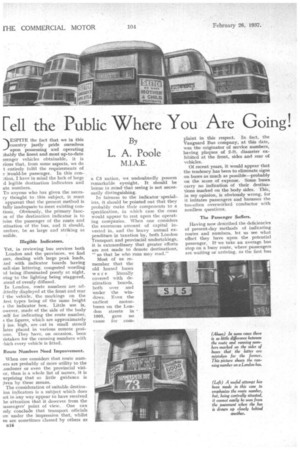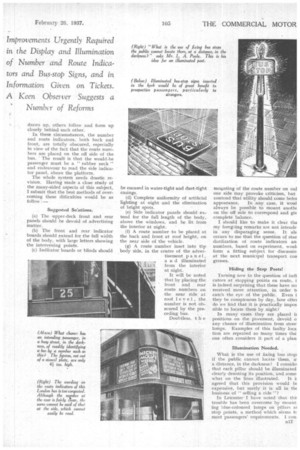Fell the Public Where You Are Going!
Page 50

Page 51

Page 52

If you've noticed an error in this article please click here to report it so we can fix it.
By
L. A. Poole m.I.A.E.
)ESPITE the fact that we in this country justly pride ourselves upon possessing and operating >bably the finest and most up-to-date ssenger vehicles obtainable, it is rious that, from some aspects, we do t _entirely fulfil the requirements of e Would-be passenger. In this con:ition, I have in mind the lack of large d legible destination indicators and ute numbers.
To anyone who has given the necesry thought to . this subject, it must apparent that the present method is tally inadequate to meet existing conLions. Obviously, the primary funcni of the destination indicator is to [vise the passenger of the route and stination of the bus, and it should, erefore, be as large and striking as Illegible Indicators.
Yet, in reviewing bus services both London and the provinces, we find ises, dealing with large peak loads, :ted with indicator boards having call-size lettering, congested wording id being illuminated poorly at night, ring to the lighting being staggered, stead of evenly diffused.
In London, route numbers are adLittedly displayed at the front and rear F the vehicle, the markings on the test types being of the same height s the indicator box. Little use is, owever, made of the side of the body self for indicating the route number, 3 the figures, which are approximately ins, high, are cut in small stencil lates placed in various remote posions. They have, on occasion, been iista,ken for the running numbers with ,hich every vehicle is fitted.
Route Numbers Need Improvement.
When one considers that route numcrs are probably of more utility to the .ondoner or even the provincial visior, than is a whole list of names, it is urprising that so little guidance is ;iveu by these means.
The consideration of suitable destinaion indicators is a subject which does Lot in any way appear to have received he attention that it deserves from the iassengers' point of view. One can only conclude that transport officials ire under the impression that, whilst ye are sometimes classed by others as B16 a CS nation, we undoubtedly possess remarkable eyesight. It should be borne in mind • that seeing is not necessarily distinguishing.
In fairness to the indicator special-. ists, it should be pointed out that they probably make their components to a specification, in which case the onus would appear to rest upon the operating companies. When one considers the enormous amount of capital invested in, and the heavy annual expenditure in taxation by, both London Transport and provincial undertakings, it is extraordinary that greater efforts are not made to denote destinations, " so that he who runs may read."
Most of us remember that the old horsed buses were literally covered with destination boards, both over and under the windows. Even the
earliest motorbuses on the London streets in 1905, gave no cause for coin
plaint in this respect. In fact, the Vanguard Bus company, at this date, was the originator of service numbers, having plaques of 2-ft. diameter exhibited at the front, sides and rear of vehicles.
Of recent years, it would appear that the tendency has been to eliminate signs on buses as much as possible—probably on the score of expense. Some buses carry no indication of their destinations marked on the body sides. This, in my opinion, is obviously wrong, for it irritates passengers and harasses the too-often overworked conductor with needless questions.
The Passenger Suffers.
Having now described the deficiencies of present-day methods of indicating routes and numbers, let us see what effect they have upon the potential passenger. If we take an average bus stop on a busy route, where passengers are waiting or arriving, as the first bus draws up, others follow and form up closely behind each other.
In these circumstances, the number and route indicators, both back and front, are totally obscured, especially in view of the fact that the route numbers are placed on the off side of the bus. The result is that the would-he passenger must be a "rubber neck " and endeavour to read the side indicator panel, above the platform.
The whole system needs drastic revision. Having made a close study of the many-sided aspects of this subject, I submit that the best methods of overcoming these difficulties would be as follow :— Suggested So!utions.
(a) The -upper-deck front and rear panels should be devoid of advertising matter.
(b) The front and rear indicator boards should extend for the full width of the body, with large letters showing the intervening points.
(c) Indicator boards or blinds should be encased in water-tight and dust-tight casings.
(d) Complete uniformity of artificial lighting at night and the elimination of bright spots.
(e) Side indicator panels should extend for the full length of the body, above the windows, and be lit from the interior at night.
(f) A route number to be placed at the back and front at roof height, on the near side of the vehicle.
(g) A route number inset into the body side, in the centre of the advertisement panel, a n d illuminated from the interior at night.
It will be noted that by placing the front and rear route numbers on the near side at roof level, the number is not obscured by the preceding bus.
Doubtless, t h e mounting of the route number on onl one side may provoke criticism, but contend that utility should come betas appearance. In any case, it wool always be possible to mount anothe on the off side to correspond and giv complete balance.
I should like to make it clear tha my foregoing remarks are not intende in any disparaging sense. It als occurs to me that the question of stan dardization of route indicators an numbers, based on experiment, woul. form a fitting subject for discussio. at the next municipal transport con gresses.
Hiding the Stop Posts!
Turning now to the question of indi cators at stopping points en route, i is indeed surprising that these have no received more attention, in order tt catch the eye of the public. Even i they be conspicuous by day, how oftet do we find that it is practically impos sible to locate them by night?
In many cases they are placed it positions on the pavement, devoid o any chance of illumination from stree lamps. Examples of this faulty loca tion are repeated so Many times tha one often considers it part of a plan Illumination Needed.
What is the use of fixing bus stops if the public cannot locate them, at a distance, in the darkness? I considet that each pillar should be illuminated clearly denoting its position, and some what on the lines illustrated, It is agreed that this provision would be expensive, but surely it is all in the business of " selling a ride " ?
In Leicester I have noted that this trouble has been overcome by mount. ing blue-coloured lamps on pillars at stop points, a method which Seems te meet passengers' requirements. I con ler, however, that the wording, Bus Stop," should be illuminated in ier to aid strangers, who are not painted with the local blue-light stom.
It is surprising what drab colours e often used for the stop plates. .rely these should be of bright and en gaudy hues, in order to attract tention?
Another point which seems to be )rthy of attention is the imparting information on tickets. The ticket achine, as used by many operators, idoubtedly scores in the matter of dckness, as compared with the loose:ket system, but it would appear to fail in not giving the passenger information as to the name of the point where he should alight.
There is still a further point, which I consider requires serious consideration. This is in connection with the loading of passengers at picking-up points.
From my own experience, particularly in industrial centres, the method of allowing passengers on board is reminiscent of a football scrum, and it is difficult to conceive why this mad rush is tolerated by the responsible officials. Suitable arrangements should be made and enforced, as in Bradford, Birmingham and some other places. In my opinion, the queue system should be generally adopted.




























































































